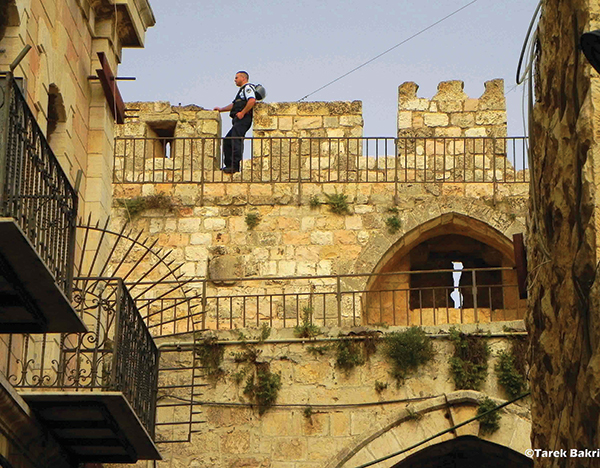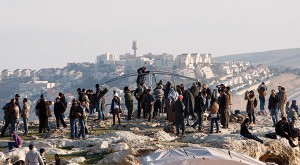
Since its occupation in 1967, East Jerusalem and its surroundings have been under Israeli jurisdiction and the administration of the Israeli Jerusalem City Council.i Israel has strived to strengthen the Jewish presence in the city through imposing planning policies that encourage the development of Jewish settlements while simultaneously limiting the development and expansion of Palestinian neighborhoods.
After occupying the city, Israel cancelled the Jordanian planning ordinance and confiscated large areas of land for the construction of Israeli settlements.ii From the beginning, the Israeli planning system did not recognize the distinct characteristics of the Palestinian towns and villages and their specific needs. The Israeli planning authorities dealt with Palestinian areas in East Jerusalem as rural areas with low densities rather than as urban areas with high densities and major infrastructure. As a result, the Palestinian neighborhoods became isolated from each other and from their surroundings, which increased the fragmentation of the city. Israel has since continued to violate international law.iii

Throughout the last 48 years, East Jerusalem has been affected by various local and regional planning schemes, the most recent one being that of Jerusalem 2000.iv These planning schemes have negatively affected the city’s built-up environment and the quality of life of its Palestinian residents. Israeli plans for the city have allocated vast tracts of lands to settlement growth and expansion and allow for large building percentages for their settler residents. The Israeli Jerusalem Municipality has, since its establishment, been allocating tremendous portions of its funds to improve infrastructure and public services in these Jews-only settlements. At the same time, these plans have limited the development and growth of Palestinian neighborhoods. Large tracts of privately owned Palestinian lands have been designated as open areas where construction is prohibited,v and the lands allocated for future planning are already built up to their maximum capacity, leaving no room for natural growth. The average density in a Palestinian neighborhood is 13,500 persons/km2 compared to 8,300 persons/km2 in Israeli settlements. Moreover, the planning polices in East Jerusalem allow for very low building percentages and densities in the Palestinian neighborhoods, which do not meet the housing needs of the population. The average building rights in Palestinian neighborhoods range between 50 and 70 percent, compared to between 75 and 120 percent in Israeli settlements. This has led to a severe housing crisis in East Jerusalem; more than 15,000 housing units are needed today to supply the current shortage. Simultaneously, the municipal procedures and planning frameworks – by requiring difficult, lengthy, and expensive procedures – are halting the development of detailed plans by the local residents that may allow Palestinians to issue building permits, making it almost impossible for Palestinians to build. As a result, very few Palestinians manage to obtain building permits, and the majority resort to “informal” building to meet their housing needs. Building without permits has placed thousands of Palestinian homes under demolition threats, increased the displacement risks, and burdened hundreds of families with municipal fines. Currently, more than half of the existing units in East Jerusalem are considered “illegal” by the municipality and are therefore under demolition threats.
 In terms of land provision for public services, Israeli plans fail to provide adequate lands for educational, health, social, and cultural facilities. Moreover, as a result of the biased planning policy, Palestinian neighborhoods in East Jerusalem suffer from discrimination – compared to Israeli settlements – in terms of the municipal public investments allocation. There is a lack of public investment in road networks, sewage, water and electrical infrastructure, waste collection systems, and public recreational facilities. Infrastructure services in Palestinian areas are largely inadequate and badly maintained.
In terms of land provision for public services, Israeli plans fail to provide adequate lands for educational, health, social, and cultural facilities. Moreover, as a result of the biased planning policy, Palestinian neighborhoods in East Jerusalem suffer from discrimination – compared to Israeli settlements – in terms of the municipal public investments allocation. There is a lack of public investment in road networks, sewage, water and electrical infrastructure, waste collection systems, and public recreational facilities. Infrastructure services in Palestinian areas are largely inadequate and badly maintained.
♦ The urban living environment in East Jerusalem continues to deteriorate under the restrictive political, socio-economic, and spatial policies of the Jerusalem Municipality. These policies have deprived the Palestinians living in the city from their urban rights to housing, public space, and basic urban services. Without feasible options to realize spatial planning solutions that can help generate housing, educational, and health facilities, economic opportunities and enabling building permits, more and more Palestinians are left with no option but to build “illegally” without permits in overcrowded and under-serviced neighborhoods, putting themselves under the demolition and displacement threats.
The Palestinian neighborhoods in East Jerusalem are characterized by high levels of informality, over-crowdedness, deteriorating urban conditions, poor physical infrastructure, and lack of public spaces and public services. They are becoming slum-like living environments, which negatively affects the socio-economic conditions and the quality of life of the Palestinian residents, thus increasing unemployment, poverty, and school dropout rates. The construction of the Separation Wall has exacerbated the situation. It has disconnected Jerusalem from its surroundings and from the rest of the West Bank, isolating more than 99,000 Palestinian residents of East Jerusalem behind the Separation Wall, with poor living conditions and complete detachment from the city. As a result, the urban fabric of East Jerusalem has lost its contiguity, and what has remained are enclaves surrounded by Israeli settlements, the Separation Wall, and checkpoints.

Realizing the complexity and severity of the urban situation in East Jerusalem, it is very important to address the above-mentioned challenges and start to look for a viable solution that protects residents’ rights to their city. In light of the absence of a formal Palestinian authority in the city, community-driven and community-led initiatives to address land and planning complexities are important in order to realize any results. A formal coordination and administrative body that includes the various Palestinian actors, UN agencies, NGOs, and private-sector establishments is needed to oversee and govern various relief and development interventions in the city, and to tackle the most urgent and pressing problems. Such a body should ensure the effectiveness of implementation and act as a Palestinian reference for the community. In addition, more advocacy efforts are needed to inform the international community, diplomatic missions, and human rights organizations about the deteriorating conditions in East Jerusalem in order to pressure the Israeli government to stop home demolitions, approve more master and detailed plans for the Palestinian neighborhoods, provide adequate infrastructure, and grant a sufficient number of building permits to meet the needs of the community. Until a final political solution is achieved to end the occupation in East Jerusalem, an immediate intervention is needed to alleviate the living conditions of Palestinians in East Jerusalem and to support their resilience in the city.
» Anjad Hithnawi is an architect and urban planner who has been working in the urban development field in Palestine since 2007, with UN agencies, international NGOs, and academic institutions. She holds a master’s degree in urban design and a bachelor’s degree in architecture.
» Lubna Shaheen (PhD) is a spatial planner who worked as an assistant professor at the Department of Architectural Engineering at Birzeit University. She also worked as a consultant and senior planner with several local and international consulting firms. Currently she works with UN-Habitat as a project manager for the Urban Planning Support Program for the Palestinian Communities in East Jerusalem.
…………………………………………………….
i The annexation of East Jerusalem was never recognized internationally. The UN Security Council censured it “in the strongest terms” and declared it “null and void,” adding that “it must be rescinded forthwith.” Under international law it therefore continues to be part of the West Bank and is considered to be “occupied” by Israel.
ii 52 percent of land in East Jerusalem is allocated for settlement construction.
iii International law requires the occupying power to take measures to ensure the welfare of the occupied, prohibits displacing the occupied within or outside the occupied territory, prohibits the transfer of the civilian population of the occupation power into the occupied territory, and prohibits the confiscation and destruction of the private property of the occupant.
iv Though not formally endorsed, Jerusalem 2000 is being used by the Israeli Municipality.
v 35 percent of land in East Jerusalem is designated as green or open areas where construction is prohibited.

